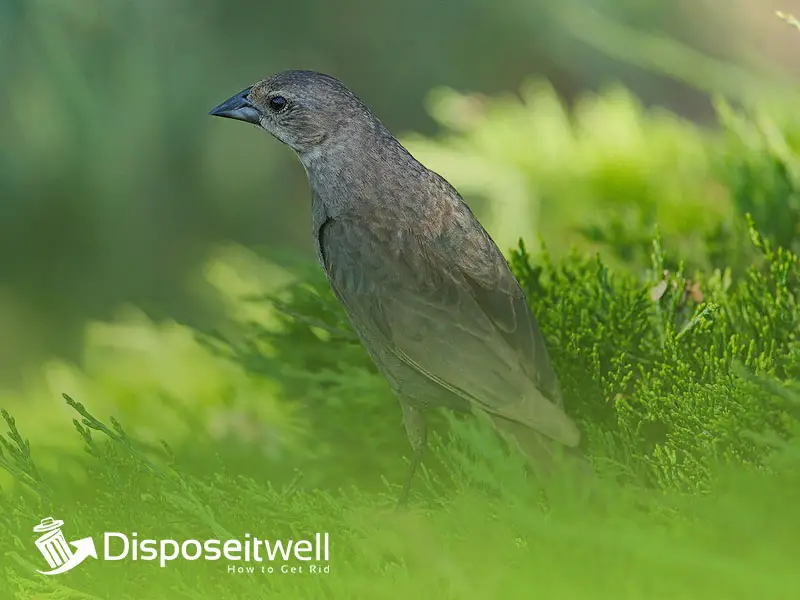Cowbirds can pose a significant threat to the delicate balance of ecosystems, as these brood parasites lay their eggs in the nests of other bird species. We will pave your path toward effective and authentic solutions against this common threat.
To combat the intervention of Cowbirds, it is crucial to employ a multi-faceted approach. The most efficient strategies for getting rid of cowbirds are habitat modification, nest monitoring, and the use of deterrent techniques. After implementing these techniques, one can restore equilibrium in their local avian communities with ensured survival of native bird species for generations to come.
This article will let you explore the world of cowbird control, ensuring a peaceful and thriving bird sanctuary in your backyard.
Identifying Cowbirds
Cowbirds, specifically the Brown-headed Cowbird (Molothrus ater), are easily recognizable with their glossy black plumage and distinctively brown heads. Males exhibit a conspicuous courtship display, while females possess a slightly duller appearance.
These birds are brood parasites, meaning they lay their eggs in the nests of other bird species, shirking parental responsibilities and potentially harming the host species’ reproductive success.
Methods to Get Rid of Cowbirds

Habitat Modification:
- Creating or enhancing habitat features that discourage cowbirds is an effective strategy.
- Dense shrubbery and canopy cover can limit cowbirds’ access to host nests.
- Providing native vegetation that is unsuitable for cowbirds to build their nests can help protect vulnerable bird species.
Nest Removal:
- Regularly monitoring nests and promptly removing any cowbird eggs is crucial.
- This prevents the development of cowbird chicks and reduces their impact on host species.
- Care should be taken to identify and remove only cowbird eggs to avoid accidentally removing host species’ eggs.
Trapping and Removal:
- Selective trapping methods can be employed to capture cowbirds and remove them from the area.
- Traps specifically designed for cowbirds, such as funnel traps or decoy traps, can be effective.
- It is important to release captured cowbirds away from nesting areas to prevent their return.
Nest Parasitism Countermeasures:
- Installing cowbird-resistant nest boxes or providing alternative nesting opportunities can help mitigate the risk of parasitism.
- Cowbird-resistant nest boxes have smaller entrance holes that prevent cowbirds from entering.
- Providing suitable nesting sites specifically designed for vulnerable bird species reduces their dependency on natural nests.
Predator Deterrence:
- Implementing measures to deter nest predators indirectly reduces cowbird parasitism.
- Installing predator guards on nest boxes or using scare devices, such as visual deterrents or ultrasonic devices, can create a less favorable environment for cowbirds.
- By reducing the presence of predators, host species’ nests become less attractive to cowbirds.
Managing Bird Feeders:
- Ensuring bird feeders are designed to discourage cowbird access is essential.
- Using small mesh sizes or cage-like structures around feeders prevents cowbirds from accessing the food source.
- This reduces the congregation of cowbirds around feeding areas, minimizing the risk of parasitism on host species’ nests.
Scare Tactics:
- Utilizing visual and auditory scare tactics can effectively deter cowbirds from nesting areas.
- Decoy birds, such as predator models or larger bird species, can create the impression of a threat to cowbirds.
- Playing distress calls or employing predator mimicry techniques can also disrupt cowbirds’ reproductive patterns and discourage their presence.
The Problem and Impact of Cowbirds
- Cowbirds are a significant concern for conservationists and bird enthusiasts.
- They have a detrimental impact on native bird populations.
- Cowbirds lay their eggs in the nests of other birds, burdening the host species.
- Host species are forced to raise unfamiliar cowbird chicks.
- Cowbird chicks outcompete the host species’ own offspring for resources.
- This competition can lead to reduced reproductive success for the host species.
- Vulnerable species may experience population declines due to cowbird parasitism.
FAQs
Are cowbirds invasive?
Cowbirds, particularly the Brown-headed Cowbird, are considered native to North America, rather than invasive species. However, their behavior of brood parasitism can have detrimental effects on native bird populations.
What food do cowbirds hate?
Cowbirds are generalist feeders and their diet consists of seeds, insects, and fruits. There is no specific food that cowbirds hate, as their feeding preferences are not exclusive to particular items.
Is there anything good about cowbirds?
While cowbirds’ brood parasitism behavior can have negative impacts on other bird species, it is important to note that they have evolved as part of the natural ecosystem. Cowbirds have been known to contribute to the control of certain insect pests, and they may have indirect ecological roles. However, their negative effects on native bird populations and their potential to disrupt the delicate balance of ecosystems make it necessary to manage their impact effectively.
Conclusion
Cowbirds, particularly the Brown-headed Cowbird, are a significant threat to ecosystems due to their brood parasitism behavior. To address this issue, a comprehensive approach is necessary. Strategies such as habitat modification, nest monitoring, deterrent techniques, trapping and removal, nest parasitism countermeasures, predator deterrence, managing bird feeders, and scare tactics can effectively combat cowbird parasitism.
By implementing these methods, we can protect vulnerable bird species and restore balance in avian communities. Cowbird chicks outcompete host species’ offspring, leading to reduced reproductive success and potential population declines.
It is crucial to take action and ensure the survival of native bird populations by mitigating the impact of cowbirds through these multifaceted strategies.
My name is Ella Vicedomine and I’m the founder of this blog. The aim is to start this informational blog to guide people on how to dispose of waste things around in the house but in the right way.

